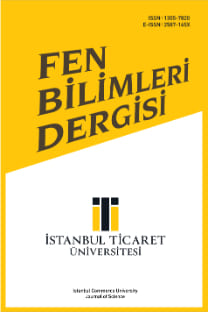SAYMA SÜREÇLERİYLE YAŞAM SÜRDÜRME ANALİZİ
Yaşam sürdürme analizi (survival analysis), iyi tanımlanmış bir başlangıç noktasından itibaren ölçülen ve önceden tanımlanmış herhangi bir olayın gerçekleşmesine kadar geçen zaman sürelerinden oluşan verinin analizinde kullanılmaktadır. Yaşam sürdürme zamanlarından oluşan yaşam sürdürme verisi, çoğu zaman durdurmaya (censoring) bağlı olarak tamamlanamamıştır ve bilinen istatistiksel yöntemler kullanılamamaktadır. Yaşam sürdürme fonksiyonu ve hazard hızı, bütün yaşam sürdürme analizi teorisinde açıklanmaya çalışılan iki temel kavram olmaktadır. Bu kavramları açıklamak üzere özellikleri birbirlerinden farklı pek çok model kurulmaktadır. Bu çalışmada, temel olarak hazard hızını modelleyen ve yaşam sürdürme analizinde yaygın olarak kullanılan bazı modeller sayma süreçleri çerçevesinde incelenmeye çalışılmıştır.
Anahtar Kelimeler:
Yaşam sürdürme analizi, hazard hızı, Cox model, sayma süreci, toplamsal hazard modeli, çarpımsal-toplamsal hazard modeli, kırılganlık
COUNTING PROCESS IN SURVIVAL ANALYSIS
The survival analysis is used to analyzing survival data which are measured from well defined starting point to the occurrence of well defined any event. Survival data are consisting of the survival times and they are frequently incomplete observations due to censoring. So, ordinary statistical methods cannot be used. The survival function and the hazard rate are two basic concepts to be explained in theory of survival analysis. There are many models with different properties to explain these concepts. In this study, in the context of counting process some models that are used in the survival analysis have been considered and basically have been explained hazard rate.
Keywords:
Survival analysis, hazard rate, Cox’s model, counting process, additive hazards model, multiplicative-additive hazards model, frailty,
___
- Aalen, O. O., (1978b), “Nonparametric inference for a family of counting processes”, Annals of Statistics, 6, 701–726.
- Aalen, O. O., (1980), “A Model for Nonparametric Regression Analysis of Counting Process. In Lectures notes on Mathematical Statistics and Probability”, Klonecki W., Kozek A., Rosinski J., eds. Springer-Verlag, New York, 1-25.
- Aalen, O. O., Borgan, Ø., Gjessing, H., K., (2008), Survival and Event History Analysis: A Process Point of View. Springer-Verlag, NewYork.
- Aalen, O. O., Anderson, P., Borgan, Ø., Gill, R., Keiding, N., (2009), “History of applications of martingales in survival analysis”, Electronic Journal for History of Probability and Statistics. June, Vol. 5 No.1.
- Andersen, P. K., Gill, R. D., (1982), “Cox’s Regression Model for Counting Process: A Large Sample Study”, Annals of Statistics, 10, 1100-1120.
- Andersen P. K, Borgan Ø, Gill R, Keiding N., (1993), Statistical Models Based on Counting Processes. Springer-Verlag, NewYork.
- Andersen, P. K., Keiding, N., (1998), “Survival Analysis: overview”, In Encyclopedia of Biostatistics (eds P. Armitage and T. Colton), vol.6, 4452-4461. Wiley, Chichester.
- Clayton D, Cuzick J., (1985), “Multivariate generalizations of the proportional hazards model”, Journal of the Royal Statistical Society (A), 148: 82-117.
- Cox, D. R., (1972), “Regression models and life tables”, Journal of the Royal Statistical Society, B 34, 187-220.
- Cox D. R., (1975), “Partial Likelihood”, Biometrika, 62: 269-276.
- Fleming, T. R., Harrington, D. P., (2005), Counting Processes and Survival Analysis. Wiley, New York.
- Gill, R. D., (1980), “Censoring and stochastic integrals”, Mathematical Centre Tracts, Vol. 124, Mathematisch Centrum, Amsterdam.
- Gill, R. D., (2005), “Product-integration. In Encyclopedia of Biostatistics (eds P. Armitageand, T. Colton), vol. 6, 4246-4250.
- Gill, R. D., Johansen, S., (1990), “A survey of product-integration with a view towards application in survival analysis”, Annals of Statistics, 18, 1501-1555.
- Gustafson, P., (1995), “Hierarchical Bayesian analysis of clustered survival data", Technical Report #144, Department of Statistics, University of British Columbia, Canada.
- Hanagal D. D., (2011), Modelling Survival Data Using Frailty Models. Chapman and Hall.
- Hougard P., (1984), “Life table methods for heterogeneous populations”, Biometrika, 71: 75-83.
- Hougard P., (1986), “Survival models for heterogeneous populations derived from stable distributions”, Biometrika, 73: 387-396.
- Huber-Carol C, Vonta F., (2004), “Frailty models for arbitrarily censored and truncated data”, Lifetime Data Analysis, 10: 369-388.
- Kaplan, E. L., Meier, P., (1958), “Non-parametric Estimation From Incomplete Observations”, Journal of the American Statistical Association, 53, 457–481.
- Lin, D. Y., Ying, Z., (1994), “Semiparametric analysis of the additive risk model”, Biometrika, 81, 61-71.
- Mantel N., Haenszel W., (1959), “Statistical aspects of the analysis of data from retrospective studies of disease”, Journal of the National Cancer Inst., 22: 719-748.
- McKeague, I. W., Sasieni, P. D., (1994), “A partly parametric additive risk model”, Biometrika, 81, 501-514.
- Nelson, W., (1972), “Theory and applications of hazard plotting for censored failure data”, Technometrics, 14, 945–965.
- Sinha, D., (1993 a), “Semiparametric Bayesian analysis of multiple time data". J. Amer. Statist. Assoc., 88, 979-983.
- Tarone E. R, Ware J., (1977), “On distribution-free tests for equality of survival distributions”, Biometrika, 64: 156-160.
- Vaupel, J. W., Manton, K. G., Stallard, E., (1979), “The impact of heterogeneity in inddividual frailty on the Dynamics of mortality”, Demography, 16, 439-454.
- Wienke A., (2011), Frailty Models in Survival Analysis. Chapman and Hall.
- Yashin A. I,, Vaupel J. W, Iachine A. I., (1995), “Correlated ındividual frailty: An advantageous approach to survival analysis of bivariate data”, Mathematical Population Studies, Vol. 5(2): 145-159.
- Yau K. K. W., (2001), “Multilevel models for survival analysis with random effects”, Biometrics, 57: 96-102.
- ISSN: 1305-7820
- Yayın Aralığı: Yılda 2 Sayı
- Başlangıç: 2002
- Yayıncı: Doç. Dr. Necip Şimşek
Sayıdaki Diğer Makaleler
Bahadir GÜLSÜN, Gülbahar ŞAHİN
TEK MAKİNE ÇİZELGELEME PROBLEMİ İÇİN DAL SINIR YAKLAŞIMI
Sebrina Tadesse DAWD, Berk AYVAZ
TÜRKİYE’DEKİ DOĞAL GAZ TÜKETİMİ VE GRİ TAHMİN METODUYLA TAHMİN EDİLMESİ
SAYMA SÜREÇLERİYLE YAŞAM SÜRDÜRME ANALİZİ
VERİ VE AĞ GÜVENLİĞİ İÇİN UYGULAMA VE ANALİZ ÇALIŞMALARI
Ömer Faruk KAYA, Erdinç ÖZTÜRK
OTOPARK SİSTEMLERİNDE İSTANBUL KART UYGULAMASI İSPARK ÖRNEĞİ
